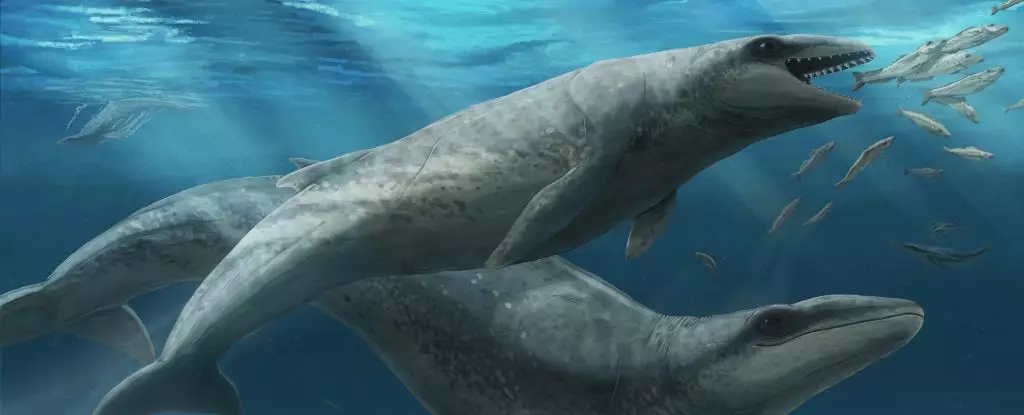Recent paleontological discoveries have challenged our preconceived notions about prehistoric marine life, highlighting a fascinating chapter where size defied expectations. When we imagine ancient whales, it’s tempting to picture colossal creatures that dominate the ocean’s depths. Yet, the recent unveiling of *Janjucetus dullardi*—a miniature whale no larger than a human—forces us to reconsider this narrative. This small, shark-like baleen whale from 26 million years ago demonstrates that the ocean’s ancient ecosystems were filled with miniature predators and prey, intricately balanced systems that don’t fit conventional wisdom about marine megafauna. While big animals often symbolize power and dominance, these tiny whales reveal a different story: that survival and adaptation are not solely determined by size but also by niche specialization and evolutionary experimentation.
This discovery also serves as a stark reminder of how much remains hidden beneath the waves, both literally and figuratively. The fossil, a rare partial skull with detailed inner ear structures and teeth, is a window into a world where small size might have provided crucial survival advantages. It contradicts the modern association of whales with massive bulk and reminds us that evolutionary pressures can favor smaller, more agile, and perhaps more adaptable marine mammals during certain epochs. Such creatures likely played pivotal roles in their ecosystems, creating a complex web of interactions that are still largely mysterious today. This insight challenges not only our understanding of whale evolution but also the broader narrative of marine biodiversity’s progression through epochs.
Rethinking Evolutionary Success and Extinction
The discovery of *Janjucetus dullardi* sparks a critical debate about what constitutes evolutionary success. For decades, the narrative has been dominated by the idea that in the animal kingdom, bigger is often better—magnificence and size equate to domination. However, this fossil suggests that size isn’t always an advantage. Instead, these small whales thrived in their niche environments, employing their big eyes and razor-sharp teeth to hunt in a manner reminiscent of small predators like sharks. This indicates a diversification strategy, where multiple survival tactics coexisted, each with its own merits.
Yet, the eventual extinction of mammalodontids like *Janjucetus* raises questions about whether size played a role in their decline. As larger, more adaptable whales with baleen filter-feeding structures emerged and diversified, smaller relatives disappeared. This pattern suggests that winning evolutionary strategies are fluid—what works at one stage of Earth’s history might become obsolete later. This realization should humble us; it underscores the importance of preserving biodiversity, including vulnerable small species that could hold clues to resilience and adaptation. Loose dependence on a few successful traits—like size—can make a lineage vulnerable to environmental upheavals, a lesson that remains relevant as contemporary ecosystems face unprecedented challenges.
Implications for Modern Conservation and Scientific Inquiry
From a center-leaning, liberal perspective, the paleoecological insights provided by fossils like *Janjucetus dullardi* reinforce the urgency of protecting biodiversity today. They remind us that evolution is unpredictable and that every organism plays a role in the intricate tapestry of life. Our current obsession with megafauna—whether charismatic megaspecies or economically vital organisms—should not overshadow the importance of smaller, less conspicuous species. These tiny whales reveal that size does not define importance or potential; in fact, they might have been more resilient in their time, adapting rapid changes with agility that bigger animals could not afford.
Furthermore, this discovery emphasizes the importance of supporting scientific research that digs into our planet’s deep past. Without the fossilization and meticulous study of these ancient remains, our understanding of life’s complexity would be sorely lacking. It reminds us that the health of today’s oceans—choked by pollution, climate change, and overfishing—depends on a nuanced understanding of evolutionary history and ecological balance. Protecting the diversity of marine life today ensures that future generations can continue exploring the mysteries of our world, just as scientists explore the ancient waters that once teemed with tiny, predatory whales.
In essence, the tiny whale fossils challenge us to broaden our understanding of success, resilience, and adaptation within marine ecosystems. They compel us to see beyond size as the sole marker of importance and recognize that every creature, no matter how small, is a vital part of Earth’s evolutionary narrative. As stewards of this planet, our role is to safeguard this delicate heritage—understanding that the tiniest species might hold the most profound lessons for our future.


Leave a Reply